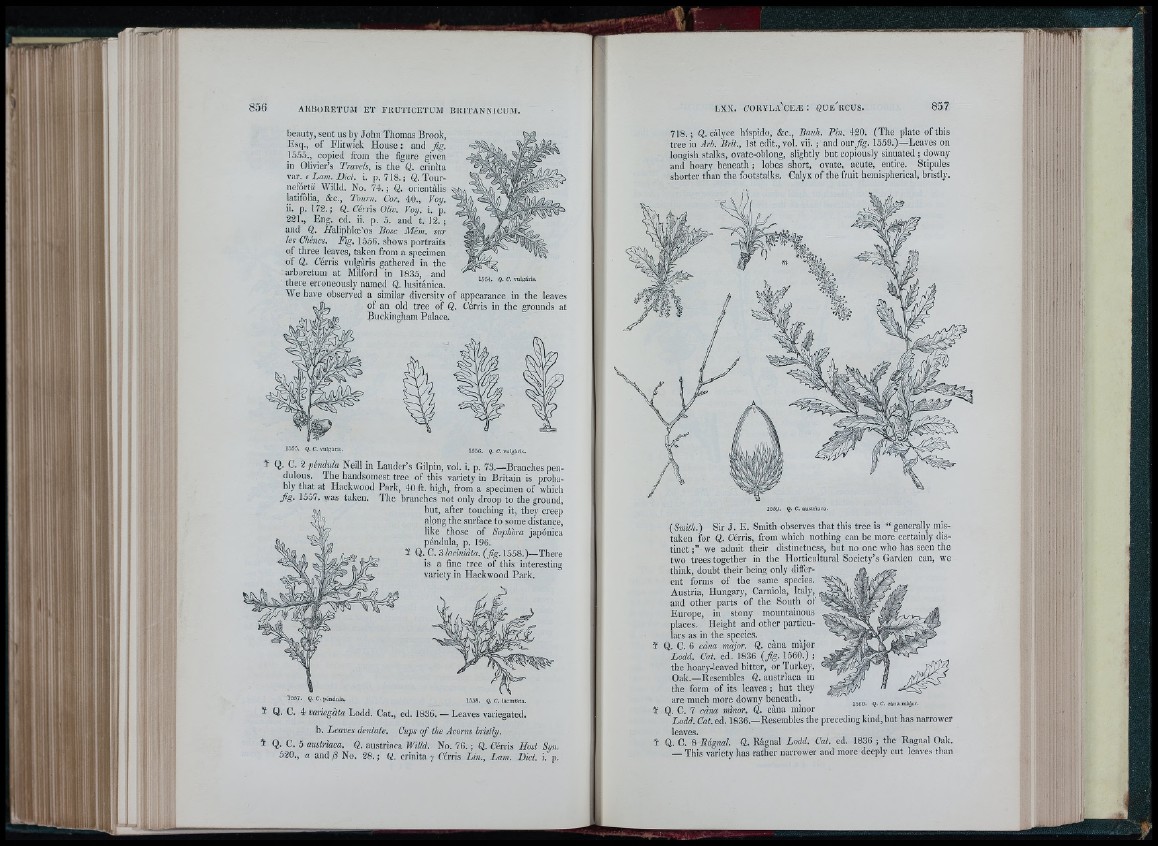
beauty, sent us by Jo h n Thomas Brook,
Esq ., o f Flitwick Ho u se : and fig .
1555., copied from th e figure given
in Olivier’s Travels, is th e Q. crinita
var. e Lam. D id . i. [). 718. ; Q. Tour-
nefórtii Willd. No. 74. ; Q. orientàlis
latifòlia, &c., Tourn. Cor. 40., Vot/.
ii. p. 172.; Q. Cérris Oliv, Fog. i. p.
221., Eng. ed. ii. p. 5. and t. 1 2 .;
and Q. /fa lip h loe 'o s Bosc M ém. sur
les Chênes. Fig. 1556. shows p o rtra its
o f th re e leaves, taken from a sjiecinien
o f Q. Cérris vulgàris g athered in th e
arboretum a t Milford in 1835, and
th e re erroneously named Q. lusitanica.
1554. Q. C. vuIsárU.
W e have observed a similar diversity o f appearance in th e leaves
o f an old tre e o f Q. Cérris in th e grounds at
Buckingham Palace.
1555. Q. C. vulgàris. 1556. Q. C. vulgaris.
Í Q. C. 2 péndula Neill in Lauder’s Gilpin, vol. i. p. 73.—Branches pen-
dulous. T h e handsomest tre e o f this variety in B rita in is probably
th a t a t Hackwood P a rk , 40 ft. high, from a specimen o f which
fig . 1557. was taken. Th e branches n o t only droop to th e ground,
but, after touching it, they creep
along th e surface to some distance,
like those o f Sophora japónica
péndula, p. 196.
¥ Q. C. 3 laciniata. (fig . 1558.)— There
is a fine tre e o f this interesting
variety in Hackwood P ark .
"1557. Ç. C. pénüula,
¥ Q. C. 4 variegàta Lodd. Cat., ed. 1836. •
1558. q . C. laciniàta.
- Leaves variegated.
m l
b. Leaves dentate. Cups o f the Acorns bristly.
¥ Q. C. 5 austrìaca. Q. austrìaca WiUd. No. 76. ; Q. Cérris Host Syn.
520., rt and /3 No. 28. ; Q. crinita y Cerris Lin., L am . Diet. i. p.
7 1 8 .; Q. calyce Mspido, See., Bauh. Pin. 420. (T h e plate o f th is
tre e in Arb. Brit., Is t edit., vol. vii. ; and o u r / g . 1559.)—Leaves on
longish stalks, ovate-oblong, slightly b u t copiously sinuated ; downy
and hoary b e n e a th ; lobes sh o rt, ovate, acute, entire. Stipules
sh o rte r th an th e footstalks. Calyx o f th e fruit hemispherical, bristly.
1559. Ç. C. aiutriaca.
(Smith.) Sir J . E . Smith observes th a t this tre e is “ generally mistaken
for Q. Cerris, from which nothing can be more certainly distin
c t we admit the ir distinctness, b u t no one who has seen th e
two tre e s toge ther in th e H o rticu ltu ral Society’s Garden can, we
think, doubt th e ir being only differen
t forms o f th e same species.
Austria, Hungary, Carniola, Italy, ^
and o th e r p arts o f th e S o u th oi
Eu ro p e , in stony mountainous
places. Height and o th e r particulars
as in th e species.
¥ Q. C. 6 càna màjor. Q. càna màjor
Lodd. Cat. ed . 18.36 ( fig . 1560.) ;
th e hoary-leaved b itte r, or Turkey,
Oak.—Resembles Q. au s trìa c a in
th e form o f its leaves ; b u t they
are much more downy b en e a th .
¥ Q„ C. 7 càna minor. Q. càna minor
15C0. Q. C. càna màjor.
Lodd. Cat. ed. 1836.— Resembles th e preceding kind, b u t has narrower
leaves.
¥ Q. C. 8 Rágnal. Q. Rágnal Lodd. Cat. ed. 1836 ; th e Ragnal Oak.
— This variety has rath er narrower and more deeply cu t leaves than
■I I: iii: